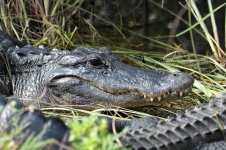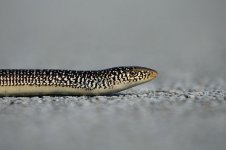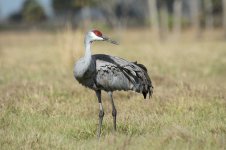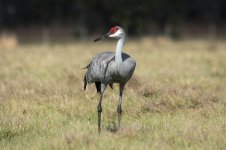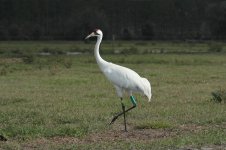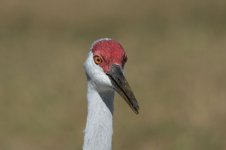19 December. The Everglades
Having barely been in bed for four hours, and slightly warped by the time difference, we were up at the crack of dawn to begin the birding adventures. Staggered out into the parking lot, palm trees plentiful, a warm sun just rising. European Starlings, two Common Mynas, a little flock of Monk Parakeets and a couple of House Sparrows ...hardly classic American birding to kick things off!
Just twenty minutes to the west of Florida City however lay the entrance to the legendary Everglades, a vast wetland of saw grass and prairie, 20,000 square kilometres of pristine habitat full of birds, alligators and others critters to delight. So scoffing down breakfast and chucking coffee into a thermos, off we went. A short drive through agricultural areas, Northern Mockingbirds, American Kestrels and umpteen Boat-tailed Grackles on roadside wires, waves of White Ibis and Cattle Egrets winging over, and then we were there. Tricoloured Herons and Great Egrets in the first marshes, a wave of Yellow-rumped Warblers in trees adjacent to the visitor centre. Having paid to enter, our first port of call was the Anhinga Trail, a short trail that led along an embankment, then circled on a boardwalk through the wetlands. A bunch of Red-shouldered Hawks on bushes just before we arrived, then an enormous flock of Black Vultures waiting to ambush us as we entered the parking lot! Dozens of them, and ambush is the right word, as I exited the car, hordes of them lolloped over, immediately forming a circle penning us in, with others plonking down on the car roof! I am far too skinny to be viewed as potential dinner, na these vultures had the actual car in their sights! Signposts warned of the danger - these vultures were the hoodlums of the 'hood', wanton damage their thing. Apparently they have taken a like to windscreen wipers and rubber window trims! Thoughtfully the national park authorities leave a big box of tarps for visitors to cover their cars, so ten minutes later, car now wrapped up like an early Christmas present, we were ready to begin exploration.
And fantastic it was. Almost needing a nudge to get them out of the way, Anhingas, Great Blue Herons and Black Vultures littered the path, diminutive Green Herons hunted from lily pads and Pied-billed Grebes bobbed on open patches. Overhead, a Short-tailed Hawk rose on the developing thermals, trillions of Black and Turkey Vultures now also circling. One Common Yellowthroat popped out, so too a little flock of Blue-grey Gnatcatchers. Double-crested Cormorants, White Ibis, Common Gallinules and Belted Kingfisher also present.
An hour or so later, many photographs already taken, it was time to continue, our ultimate destination the Flamingo campsite on Florida Bay. Many stops on route - Alligators lazing on the grassy sidewalks, Ospreys fairly common, numerous herons and egrets of assorted types, but the best stop was at Mahogany Hammock. The hammocks in the Everglades are small islands of tropical forest within the sea of grasses, typically either dominated by palms or hardwoods. Mahogany Hammock contains the largest mahogany tree in the United States and the trail that meanders around the hammock is a delight, the dense vegetation and drift of butterflies suggestive of a wild jungle rather than isolated patch. In winter many of these hammocks harbour flocks of warblers and it was these that I hoped to find. Twenty minutes of slowly working the habitat, then bingo! On branches dripping with epiphytes, a rapidly moving mixed flock ...Blue-grey Gnatcatchers leading the way, a dozen or Yellow-rumped Warblers, then a flash of colour as a dazzling Prairie Warbler hopped into view, then a cracking Northern Parula (my first since one on the Isles of Scilly in 1985!). Birds flitting each and every way, then a real jewel appeared from nowhere, one splendid Black-throated Green Warbler. Two Blue-headed Vireos next, then creeping up the branches like humbugs on legs, a superb Black-and-White Warbler, another following shortly after. Phew, that was a moment of excitement, and then the branches began to fall silent, the flock moving off into the depths of the hammock.
By now early afternoon and a splendid 29 C, it was time to get down to Flamingo to erect the tents. A few stops on route added an enormous flock of about 600 Tree Swallows, as well as assorted ducks such as Blue-winged Teal and Ruddy Duck and, as we pulled into the campsite, an American Kestrel adorned a dead tree, a Red-shouldered Hawk perched on the next along. Up went the tents, past stalked an immature Yellow-crowned Night Heron, clearly not aware of its usual nocturnal status. A bit of lazing around, watching Willets and Marbled Godwits on the adjacent mudflats, then quickly popped over to the nearby marina. Sometimes a locality for West Indian Manatee, I was quietly happy that none were present on this day (hoping to save them for a very special locality later in the trip), but two American Crocodiles cruising the waterways just off the key were most welcome!
With the tide on the rise, it was then time to plonk myself on a conveniently placed bench overlooking Florida Bay. Amongst the hordes, hundreds of Willets and White Ibis, many dozens of Little Blue Herons, one Roseate Spoonbill and, a bird I had hoped to encounter, one Reddish Egret prancing around in the shallows. Far more impressive however was a sandbank just in front of me - as the tide pushed, so it filled up: flocks of Laughing Gulls at one end, a mass of American White Pelicans in the middle, a few Brown Pelicans in their midst, but choc'a'bloc up the other end, at least 400 Black Skimmers, very nice indeed. Even more so, when the tide periodically pushed them into the air, a mass swirl of black and white as they wheeled round to resettle.
Ever-present ospreys completed the picture and as sunset began to approach, I departed for a quick look for Lesser Nighthawks around Eco Pond. None seen, the best birds there being two American Avocets ...accompanied by rather many mosquitos.
And with that, end of day one, one quite contented observer clambered into his tent, next morning I had ideas to be up pre-dawn.







